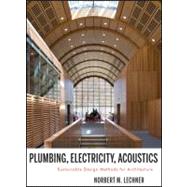
Note: Supplemental materials are not guaranteed with Rental or Used book purchases.
Purchase Benefits
What is included with this book?
Acknowledgments xi
1. Electricity – Basic Concepts 1
1.1 Introduction 2
1.2 History of Electricity 2
1.3 The Water Analogy 4
1.4 Ohm’s Law 6
1.5 Types of Electricity 6
1.6 Power Factor 9
1.7 Types of Circuits 11
1.8 Power Generators in Series and Parallel 15
1.9 Voltage Drop 16
1.10 Electrical Power 18
1.11 Electrical Energy 19
1.12 Paying for Electricity 20
1.13 Reduction in Maximum Demand 22
1.14 Transformers 23
1.15 Electricity and Safety 24
1.16 Electromagnetic Fields (EMF) 26
1.17 Conclusion 26
Resources 26
2. Electrical Distribution in Buildings 27
2.1 Introduction 28
2.2 A Brief Historical Perspective 28
2.3 Centralized Electrical Power 30
2.4 Decentralized and Private Sources of Electricity 31
2.5 Electrical Distribution in Small Buildings 32
2.6 Electrical Distribution in Large Buildings 36
2.7 Switches, Fuses, and Circuit Breakers 39
2.9 Conduits and Raceways 42
2.10 Office Landscapes 43
2.11 Electrical Safety Systems 47
2.12 Low-Voltage Circuits 50
2.13 Emergency Power 51
2.14 Communication and Building Control Wiring 53
2.15 Electrical Construction Drawings 56
2.16 Lighting Protection 56
2.17 Sustainability 58
2.18 Conclusion 59
Resources 59
3. Plumbing—Water Supply 61
3.1 Introduction 62
3.2 Brief History of Water Supply 63
3.3 Sources of Drinking Water 64
3.4 Water Use 67
3.5 Private Water Supply 68
3.6 Rainwater Harvesting 71
3.7 Water Distribution in Buildings 79
3.8 Water Quality 85
3.9 Water Efficiency 85
3.10 Hot Water 88
3.11 Hot Water Conservation 97
3.12 Conclusion 103
Resources 103
4. Drainage 105
4.1 Introduction 106
4.2 Short History of Sanitary Drainage 106
4.3 Basic Principles of Drainage 114
4.4 Basic Concepts of Plumbing Fixtures 115
4.5 Drainage Piping 116
4.6 Water Closets and Alternatives 121
4.7 Composting Toilets 125
4.8 On-Site Septic Tank Systems 126
4.9 On-Site Aerobic Systems 128
4.10 Special and Innovative Treatment Systems 130
4.11 Constructed Wetlands 131
4.12 Biologic Machines 134
4.13 Graywater Systems 136
4.14 Alternative Community Sewage Systems 139
4.15 Stormwater 141
4.16 Special Drainage Systems 152
4.17 Case Study 153
4.18 Conclusions 155
Resources 155
5. Architectural Acoustics 157
5.1 Introduction 158
5.2 A Short History of Architectural Acoustics 159
5.3 The Physics of Sounds 161
5.4 The Biology of Sounds 170
5.5 Perception of Sound 175
5.6 Sound and Health 179
5.7 Sound-Absorbing Materials 180
5.8 Applications of Sound-Absorbing Materials 182
5.9 Sound Transmission 188
5.10 Design for Low Sound Transmission 189
5.11 Acceptable Noise Levels 194
5.12 Open-Plan Offices 196
5.13 Impact Noise 198
5.14 Mechanical Systems Noise Control 199
5.15 Theaters, Classrooms and Auditoriums 202
5.16 Rules for Drawing Ray Diagrams 205
5.17 Electronic Sound Systems 206
5.18 Noise Outdoors 206
5.19 Conclusions 210
Resources 211
6. Fire Protection 213
6.1 Introduction 214
6.2 A Short History of Fires in Buildings 216
6.3 Fire Principles 221
6.4 Fire Prevention 224
6.5 Passive Fire Protection 225
6.6 Detection 228
6.7 Alarms 229
6.8 Safe Egress 232
6.9 Fire Suppression 235
6.10 Non-Water Fire Suppression Systems 242
6.11 Smoke Control 243
6.12 Fire Codes 249
6.13 Elevators and Fires 250
6.14 Lightning Protection 250
6.15 Conclusion 251
7. Conveyance Systems in Buildings 253
7.1 Introduction 254
7.2 A Short History of the Elevator 254
7.3 Elevator Types 261
7.4 Elevator Design 265
7.5 Escalators 271
7.6 Moving Walkways and Ramps 275
7.7 Vertical Transport and Health 276
7.8 Special Lifts for People 280
7.9 Material Conveying Systems 282
7.10 Conclusion 284
Resources 284
Index 285
The New copy of this book will include any supplemental materials advertised. Please check the title of the book to determine if it should include any access cards, study guides, lab manuals, CDs, etc.
The Used, Rental and eBook copies of this book are not guaranteed to include any supplemental materials. Typically, only the book itself is included. This is true even if the title states it includes any access cards, study guides, lab manuals, CDs, etc.